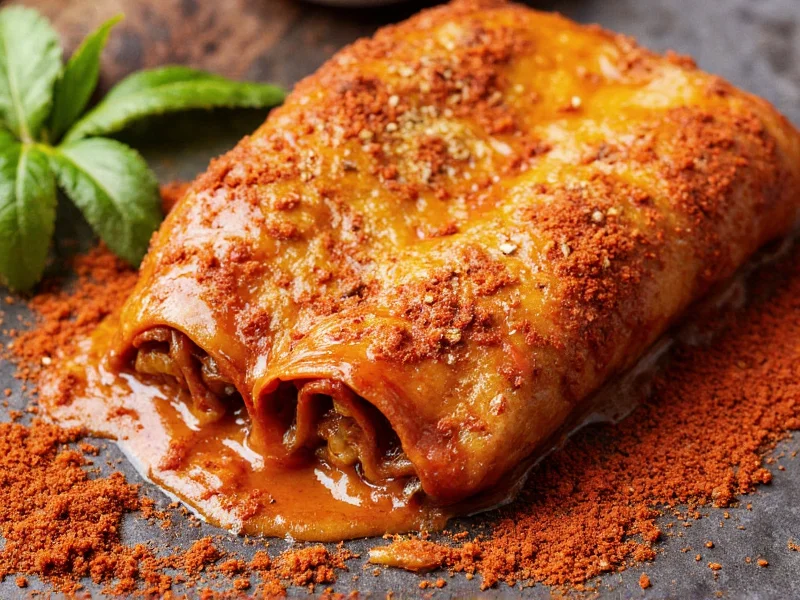Understanding enchilada spices unlocks the door to authentic Mexican cuisine. Unlike commercial seasoning packets that often contain fillers and excessive salt, traditional blends focus on pure spice harmony. This guide explores the cultural roots, essential components, and practical applications of genuine enchilada spices that elevate your cooking beyond basic Tex-Mex interpretations.
The Cultural Roots of Enchilada Seasoning
Enchiladas trace back to Mexico's pre-Hispanic era, where indigenous communities used native chilies to flavor corn tortillas. The Spanish introduction of spices like cumin and oregano created the foundation for modern blends. Traditional Mexican cooks rarely use pre-mixed "enchilada spice"—instead, they combine individual spices based on regional preferences and available ingredients.
Core Components of Authentic Enchilada Spices
While recipes vary across Mexico's diverse culinary landscape, six ingredients form the backbone of most traditional blends:
| Spice | Traditional Role | Flavor Contribution |
|---|---|---|
| Ancho chili powder | Primary flavor base | Earthy, raisin-like sweetness with mild heat |
| Cumin | Signature earthiness | Warm, slightly bitter depth (use sparingly) |
| Mexican oregano | Herbal complexity | Citrusy, floral notes (different from Mediterranean oregano) |
| Garlic powder | Aromatic foundation | Pungent sweetness without raw garlic's sharpness |
| Onion powder | Umami enhancement | Savory depth that balances acidity |
| Paprika | Color and mild heat | Rich red hue with subtle sweetness |
Regional Variations Across Mexico
Mexico's regional differences significantly impact traditional enchilada spice profiles:
- Northern Mexico: Features bold cumin presence with dried guajillo chilies providing moderate heat and tangy notes
- Central Mexico: Relies on complex chili blends like ancho, pasilla, and mulato for deep, fruit-forward flavors
- Yucatán Peninsula: Incorporates achiote paste and recado rojo for distinctive earthy, slightly bitter complexity
- Baja California: Shows Mediterranean influence with increased oregano and sometimes cinnamon
Creating Your Homemade Enchilada Spice Blend
Commercial "enchilada seasoning" often contains unnecessary additives. Crafting your own blend ensures purity and freshness. This authentic recipe yields enough for multiple batches of enchilada sauce:
Traditional Enchilada Spice Blend Recipe
Makes approximately ¼ cup (enough for 2-3 recipes)
- 2 tablespoons ancho chili powder (not regular chili powder)
- 1½ teaspoons ground cumin
- 1 teaspoon Mexican oregano, finely crushed
- 1 teaspoon garlic powder
- ½ teaspoon onion powder
- ½ teaspoon smoked paprika
- ¼ teaspoon cayenne pepper (optional for heat)
- ¼ teaspoon freshly ground black pepper
Preparation: Whisk all ingredients thoroughly in a small bowl. Store in an airtight container away from light and heat. Properly stored, this homemade enchilada spice blend maintains peak flavor for 3-4 months.
Enchilada Spices vs. Similar Blends
Many home cooks confuse enchilada spices with related Mexican seasoning blends. Understanding these differences ensures authentic results:
- Enchilada vs. Taco Seasoning: Taco seasoning contains more cumin and often includes cornstarch and sugar. Enchilada spices feature more complex chili varieties and less sweetness.
- Enchilada vs. Fajita Seasoning: Fajita blends emphasize bell pepper and citrus notes with higher salt content. Authentic enchilada spices focus on earthy chili flavors.
- Enchilada vs. Adobo Seasoning: Adobo contains vinegar and citrus elements for marinades, while enchilada spices are dry rubs designed for sauce integration.
Practical Applications in Cooking
Knowing how to properly use enchilada spices transforms your dishes:
- For sauces: Bloom spices in hot oil for 30 seconds before adding liquid ingredients to maximize flavor extraction
- With proteins: Rub chicken or pork with spice blend before slow cooking for deeper flavor penetration
- Vegetarian options: Toss roasted vegetables with spice blend and a touch of oil before filling enchiladas
- Enhancing canned tomatoes: Add 1-2 teaspoons to tomato sauce for instant flavor upgrade
Troubleshooting Common Issues
Even experienced cooks encounter challenges with enchilada spices:
- Bitterness: Caused by burnt spices or excessive cumin. Fix by adding a pinch of sugar or honey to balance.
- Weak flavor: Often results from stale spices. Always use freshly ground spices for authentic enchilada seasoning.
- Overpowering heat: Counteract with additional tomato base or a touch of dairy like Mexican crema.
- Muddy color: Use high-quality ancho chili powder for vibrant red hue without artificial coloring.
Storage and Freshness Tips
Spice quality directly impacts your enchilada's flavor profile. Follow these guidelines:
- Store in airtight glass containers away from light and heat sources
- Label containers with creation date—most spices peak within 3-4 months
- Freeze whole spices and grind as needed for maximum freshness
- Perform the "sniff test"—if aroma is weak, flavor will be compromised
- Buy small quantities from reputable spice merchants for optimal quality
Authentic Enchilada Sauce Preparation
While this guide focuses on spices, understanding how they integrate into sauce provides context:
- Heat 2 tablespoons oil in a saucepan over medium heat
- Add 3 tablespoons enchilada spice blend and toast for 30 seconds
- Gradually whisk in 2 cups chicken or vegetable broth
- Simmer 10-15 minutes until slightly thickened
- Strain through fine mesh sieve for smooth texture
- Cool before pouring over assembled enchiladas
Substitutions and Adaptations
When specific ingredients are unavailable, these substitutions maintain authenticity:
- Ancho chili powder substitute: Mix equal parts paprika and mild red pepper flakes
- Mexican oregano alternative: Combine regular oregano with a pinch of marjoram
- For heat adjustment: Use chipotle powder for smokiness or cayenne for pure heat
- Gluten-free consideration: Ensure all individual spices are certified gluten-free











 浙公网安备
33010002000092号
浙公网安备
33010002000092号 浙B2-20120091-4
浙B2-20120091-4